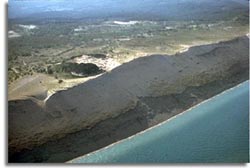 |
|
Sleeping Bear Dunes Lakeshore - NPS |
The presence of cougars (Puma concolor) in Michigan
has been debated for decades. The U.S. Fish and Wildlife Service
currently lists the eastern cougar subspecies as endangered and
presumed extinct in the wild. However, many people claim to have seen
the elusive animal. After receiving numerous such reports from the
public, Sleeping Bear Dunes National Lakeshore took a precautionary
approach in autumn of 2003. With an emphasis on public safety, park
rangers placed signs at all trailheads (excluding the Manitou
Islands) alerting visitors that observations of cougars had been
reported and how to respond to a cougar encounter.
From November 2004 through April 2005, the National
Park Service (NPS) conducted a study throughout the mainland portion
of the Lakeshore, with a goal of collecting evidence of cougar
presence. Roads and trails are numerous on the mainland, with a total
combined length of about 150 miles, crossing through all major
habitat types. The study utilized three methods to attempt to
document cougar presence: remote motion sensing camera systems; track
surveys; and investigations of reported observations of cougars or
their sign. These methods have been used in numerous studies
elsewhere in assessing cougar presence.
NPS biologists, staff and volunteers collaborated on
the effort. Seven remote sensing camera systems were placed based on
reported observations of cougars, evidence of white-tailed deer
activity, and in relationship to natural travel corridors. Greater
effort was expended in Benzie County because the majority of the
cougar sightings had been reported there. The cameras were set up at
30 different locations over the six-month period. To attract the
cats, recently road-killed deer carcasses were wired to the base of a
tree, the area scented with cougar urine, skunk essence, and/or
catnip oil, and a motion-sensing camera attached to a tree 15-30 feet
from the bait. Although cameras were operational for 863 total
nights, not a single image of a cougar was obtained. Many other
animals were documented, including bobcat, coyote, red fox, domestic
dog, house cat, raccoon, deer, several bird species, and red
squirrel. A total of 225 animal images were recorded.
Snow track surveys were conducted monthly from
January-March 2005 with trails surveyed on foot and unplowed roads
via snowmobile. Because deer typically move into the beach dune/pine
forest interface during spring, track surveys were also completed in
that habitat in April. All discernible tracks were identified to the
species level. If tracks with the potential to be cougar were
encountered, the tracks were forward and backward tracked to attempt
to locate additional sign (e.g., scat, hair) that could be identified
using DNA. Over 304 miles of road and trails were surveyed, and
nearly 460 carnivore tracks were found and identified including 22
bobcat, 300 coyote, and 40 red fox. In addition to the species found
by the camera survey, striped skunk, river otter, mink, and weasel
tracks were identified.
During the course of the study, five sightings of
cougars or their tracks were investigated, all within 24 hours of
their being reported. The observation sites and surrounding areas
were thoroughly searched, typically by two observers. No cougar sign
was found at any of these reported sighting areas. Bobcat tracks were
found at one location, coyote tracks at another, and bobcat and
coyote tracks were noted at the other two locations. The fifth
reported set of cougar tracks had been made by a domestic dog.
After six months of intensive study, staff at the
Lakeshore did not find any physical evidence to support the reported
presence of cougars in the park. Park biologists continue to maintain
a database of reported cougar sightings and investigate them as
quickly as possible. During the summer and fall of 2005, 15 cougar
sightings were reported within the Lakeshore. A remote sensing camera
was placed in the general area of several of the sightings to no
avail. Additional funding has been requested to conduct a more
intensive summer survey for cougars. Sightings, questions or concerns
can be sent electronic mail to Sleeping Bear Dunes National Lakeshore
at www.nps.gov/slbe
and click on 'Contact Us' or call park headquarters at 231-326-5134. |